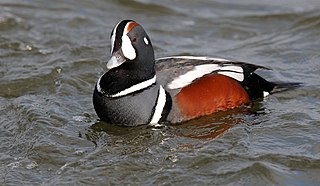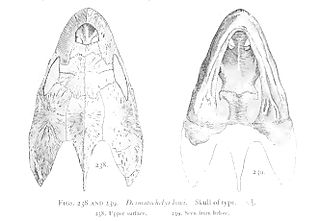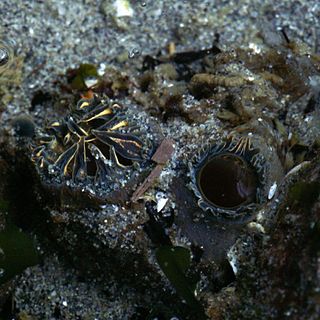Genus is a taxonomic rank used in the biological classification of living and fossil organisms as well as viruses. In the hierarchy of biological classification, genus comes above species and below family. In binomial nomenclature, the genus name forms the first part of the binomial species name for each species within the genus.

The sea ducks (Mergini) are a tribe of the duck subfamily of birds, the Anatinae. The taxonomy of this group is incomplete. Some authorities separate the group as a subfamily, while others remove some genera. Most species within the group spend their winters near coastal waters. Many species have developed specialized salt glands to allow them to tolerate salt water, but these are poorly developed in juveniles. Some of the species prefer riverine habitats. All but two of the 22 species in this group live in far northern latitudes.

Iniidae is a family of river dolphins containing one living genus, Inia, and four extinct genera. The extant genus inhabits the river basins of South America, but the family formerly had a wider presence across the Atlantic Ocean.

Orcinus is a genus of Delphinidae, the family of carnivorous marine mammals known as dolphins. It includes the largest delphinid species, Orcinus orca, known as the orca or killer whale. Two extinct species are recognised, Orcinus paleorca and O. citoniensis, describing fossilised remains of the genus. The other extinct species O. meyeri is disputed.
In biology, a monotypic taxon is a taxonomic group (taxon) that contains only one immediately subordinate taxon. A monotypic species is one that does not include subspecies or smaller, infraspecific taxa. In the case of genera, the term "unispecific" or "monospecific" is sometimes preferred. In botanical nomenclature, a monotypic genus is a genus in the special case where a genus and a single species are simultaneously described. In contrast, an oligotypic taxon contains more than one but only a very few subordinate taxa.

Lagenorhynchus is a genus of oceanic dolphins in the infraorder Cetacea, presently containing six extant species. However, there is consistent molecular evidence that the genus is polyphyletic and several of the species are likely to be moved to other genera. In addition, the extinct species Lagenorhynchus harmatuki is also classified in this genus.

Moray eels, or Muraenidae, are a family of eels whose members are found worldwide. There are approximately 200 species in 15 genera which are almost exclusively marine, but several species are regularly seen in brackish water, and a few are found in fresh water.

Strombus is a genus of medium to large sea snails, marine gastropod molluscs in the family Strombidae, which comprises the true conchs and their immediate relatives. The genus Strombus was named by Swedish Naturalist Carl Linnaeus in 1758. Around 50 living species were recognized, which vary in size from fairly small to very large. Six species live in the greater Caribbean region, including the queen conch, Strombus gigas, and the West Indian fighting conch, Strombus pugilis. However, since 2006, many species have been assigned to discrete genera. These new genera are, however, not yet found in most textbooks and collector's guides.

Tube-dwelling anemones or ceriantharians look very similar to sea anemones but belong to an entirely different class of anthozoans. They are solitary, living buried in soft sediments. Tube anemones live inside and can withdraw into tubes, which are composed of a fibrous material made from secreted mucus and threads of nematocyst-like organelles known as ptychocysts. Within the tubes of these ceriantharians, more than one polyp is present, which is an exceptional trait because species that create tube systems usually contain only one polyp per tube. Ceriantharians were formerly classified in the taxon Ceriantipatharia along with the black corals but have since been moved to their own subclass, Ceriantharia.
Robert Tucker Abbott was an American conchologist (seashells) and malacologist (molluscs). He was the author of more than 30 books on malacology, which have been translated into many languages.

Calliostoma is a genus of small to medium-sized sea snails with gills and an operculum, marine gastropod molluscs within the family Calliostomatidae, the Calliostoma top snails. Previously this genus was placed within the family Trochidae. Calliostoma is the type genus of the family Calliostomatidae.

Neritidae, common name the nerites, is a taxonomic family of small to medium-sized saltwater and freshwater snails which have a gill and a distinctive operculum.

Carcharias is a genus of sand tiger sharks belonging to the family Odontaspididae. Once bearing many prehistoric species, all have gone extinct with the exception of the critically endangered sand tiger shark.

Desmatochelys is an extinct genus of sea turtles belonging to the family Protostegidae. This genus contains two known species, D. lowii and D. padillai. D. lowii was first discovered in 1895, followed by D. padillai in 2015. Having been estimated at over 120 million years old, D. padillai is currently the oldest known species of sea turtle.
Rhytidocystis is a genus of apicomplexans. It is the only genus within the monotypic family Rhytidocystidae. The species of this genus are parasitic protozoa found in marine annelids.

Tresus is a genus of saltwater clams, marine bivalve mollusks in the family Mactridae. Many of them are known under the common name the horse clam or as species of gaper clam. They are similar to geoducks.
Oeceoclades zanzibarica is a terrestrial orchid species in the genus Oeceoclades that is endemic to eastern Tanzania in the Zanzibar Archipelago. It was first described by the English botanist V.S. Summerhayes in 1927 as Eulophidium zanzibaricum and then later transferred to the genus Oeceoclades in 1976 when Leslie Andrew Garay and Peter Taylor resurrected and revised that genus. The lanceolate leaves, which gradually taper to a point, are unique to the genus and the floral morphology is most similar to O. alismatophylla. However, the two species differ in the shape of sepals and petals and in the proportions of the labellum.

Cichliformes is an order of fishes. Its members were previously classified under the order Perciformes, but now many authorities consider it to be an independent order within the subseries Ovalentaria.
Neobodo are diverse protists belonging to the eukaryotic supergroup Excavata. They are Kinetoplastids in the subclass Bodonidae. They are small, free-living, heterotrophic flagellates with two flagella of unequal length used to create a propulsive current for feeding. As members of Kinetoplastids, they have an evident kinetoplast There was much confusion and debate within the class Kinetoplastid and subclass Bodonidae regarding the classification of the organism, but finally the new genera Neobodo was proposed by Keith Vickerman. Although they are one of the most common flagellates found in freshwater, they are also able to tolerate saltwater Their ability to alternate between both marine and freshwater environments in many parts of the world give them a “cosmopolitan” character. Due to their relatively microscopic size ranging between 4-12 microns, they are further distinguished as heterotrophic nanoflagellates. This small size ratio limits them as bacterivores that swim around feeding on bacteria attached to surfaces or in aggregates.

The Interim Register of Marine and Nonmarine Genera (IRMNG) is a taxonomic database which attempts to cover published genus names for all domains of life from 1758 in zoology up to the present, arranged in a single, internally consistent taxonomic hierarchy, for the benefit of Biodiversity Informatics initiatives plus general users of biodiversity (taxonomic) information. In addition to containing over 490,000 published genus name instances as at March 2020, the database holds over 1.7 million species names, although this component of the data is not maintained in as current or complete state as the genus-level holdings. IRMNG can be queried online for access to the latest version of the dataset and is also made available as periodic snapshots or data dumps for import/upload into other systems as desired.














